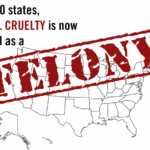When contemplating the concept of animal cruelty, one often grapples with the stark duality of human nature—the juxtaposition between empathy and malice. In this pursuit of understanding animal rights and the legal ramifications surrounding acts of cruelty, it is crucial to scrutinize the laws of specific regions: California, Canada, and Vermont. This exploration sheds light on the serious implications of animal abuse, while also inviting discourse on the societal values attributed to our non-human companions.
Firstly, in the sprawling expanse of California, the legal framework governing animal cruelty is both stringent and nuanced. Under California Penal Code § 597, individuals found guilty of animal cruelty may face a variety of penalties. The law recognizes acts such as maiming, mutilating, or torturing animals as felonies, potentially resulting in incarceration for up to three years. Furthermore, the severity of these acts could lead to felony charges, depending on the circumstances, especially if there is a history of abuse or if the inflicted harm is egregious in nature.
The legal system’s approach reflects a broader societal acknowledgment of animals not merely as property, but as sentient beings deserving of protection. This shift in perspective has prompted an evolving dialogue around animal welfare, where the justification of one’s actions towards animals is increasingly scrutinized. The depth of this issue hints at a larger cultural shift focusing on compassion and ethical treatment, challenging the archaic notion that animals exist solely for human benefit.
Transitioning beyond the U.S. border, Canada adopts a slightly different framework regarding animal cruelty. The Animal Cruelty provisions outlined in the Criminal Code of Canada explicitly denote that acts causing unnecessary suffering to animals are criminal offenses. The laws enacted in 2008 marked a significant turning point, enhancing the penalties for animal cruelty to show society’s disapproval of these heinous actions. Offenders can face imprisonment for a term of up to five years, emphasizing the seriousness with which the justice system treats animal rights. Moreover, the recognition of aggravated cruelty expands the scope of accountability, thus acknowledging the emotional and psychological impact of such offenses on not just the victims but also on the community.
This paradigm shift in Canada highlights an emerging consensus that spans beyond legislative mandates; it reflects a collective moral awakening. Many Canadians are increasingly becoming aware of animal rights, leading to heightened activism that fervently opposes cruelty. This cultural metamorphosis is profound, suggesting that deeper inquiries into the human psyche reveal a yearning for connection with other species. As society wrestles with these complex emotions, a troubling reality surfaces—where the lack of compassion may stem from deeper societal disconnections that require more than mere punitive measures to address.
In stark contrast, the situation in Vermont serves as a microcosm of the broader North American context. The state has enacted laws to combat animal cruelty, as illustrated in Title 13 of the Vermont Statutes Annotated, which outlines offenses pertaining to cruelty to animals. Act of cruel treatment, neglect, or even abandonment of animals invokes punitive measures including fines and imprisonment. For first offenses, punishments tend to be less severe; however, repeat offenders face increasing sentences and monetary penalties. This gradual escalation outlines a clear intention by the state to deter repeat offenses while still fostering a culture where education on humane treatment is prioritized.
What is particularly fascinating about Vermont’s legal approach is the emphasis on humane education as a form of prevention. The state actively promotes outreach programs aimed at teaching individuals the importance of kindness towards animals. This proactive stance suggests that the legal ramifications may not be the only path to combating cruelty; rather, fostering empathy and understanding towards animals could yield more profound and lasting effects on community values.
Moreover, the contrasting laws and cultural attitudes towards animal cruelty in California, Canada, and Vermont manifest a broader interrogation of our moral obligations. As one reflects on the varying punitive measures across these regions, it becomes apparent that the conversation around animal rights is not solely about legislative action but a reflection of societal values. There is an underlying question of how empathy for animals aligns with human societal progress. The nexus between cruelty and compassion prompts critical self-examination, especially regarding our role in advocating for those who cannot voice their suffering.
Ultimately, the penalties for animal cruelty in these regions serve as a rudimentary reminder of societal accountability. While one can be jailed for their acts, the more profound implications lie in examining why such abuse occurs in the first place. Addressing underlying issues of neglect, psychological distress, and societal indifference becomes essential in preventing such acts from manifesting. Education, community involvement, and systemic change coalesce as critical components in fostering a culture of respect and guardianship towards all living beings.
In conclusion, the legal frameworks surrounding animal cruelty in California, Canada, and Vermont underscore a collective resolve to safeguard our fellow creatures. As societal attitudes towards animals continue to evolve, we must engage in thoughtful dialogue and advocacy, embarking on a journey that champions the voices of those who cannot speak for themselves. The fight against animal cruelty is not just a legal battle; it is an ethical imperative that beckons us to reevaluate our relationship with the animal kingdom.







